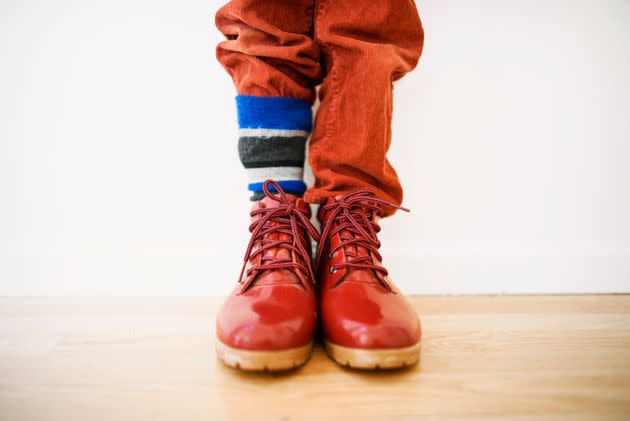The Worst Things You Can Say As A Kid Develops Their Own Sense Of Style

Every morning, my almost 5-year-old daughter stomps her feet while announcing, “Today, I’m wearing pink.”
Despite my confusion about her propensity for the color given my own reluctance to ever wear pink (I’m more of a yellow kind of gal) and my annoyance at having to obey a semi-toddler’s demands while trying to get her to school on time, I must admit that I admire Giordana’s complete devotion to a specific look.
Given her age and my motherly sense of overwhelmedness (basically, a perennial state of being), I, in fact, have not done much to foster her sense of fashion throughout her short life. I simply pick the clothes I buy for her and her siblings based on my own likes, price points, their needs and what I have come to notice looks most fitting on them.
And yet, Giordana’s daily demands have me wondering: Should I be letting her choose which pants and shirts to purchase to begin with? Is it normal for her to have such strong preferences at the age of 4? Am I to explain to her that wearing the same exact thing every day is not socially acceptable, let alone possible given our current laundry schedule?
It turns out that, according to experts, it’s never too early to start giving out proper style etiquette lessons to your offspring and it’s certainly always the right time to allow them to discover their own fashion-related dispositions.
Allowing your child to find their own style is easier said than done.
“Helping your child to find their own fashion style is a commitment that parents and caregivers have to intentionally make because it requires them to give up some of their control as their child develops their own sense of style,” said clinical child psychologist Tasha M. Brown.
The idea is that the more leeway you give your kids to navigate the subject, the more secure they will be about their sense of self.
“Let your child choose clothing while offering guidance and feedback,” said Caroline Fenkel, a licensed clinical social worker who has a focus on adolescent mental health care. “Ultimately, letting them express themselves through their fashion choices is essential, and can help build their confidence and sense of identity.”
In a way, it’s not about whether I let Giordana pick her leggings but how I respond to her choice — a reaction that will have just as much bearing on her well-being as the fashion statement she opted for.
Below, experts share a few tips that will help you navigate the whole process: from what style choices kids should be allowed to make on their own to your reactions to those preferences and more.
Start giving them choices when they’re young.
The sooner you give your kids the liberty to make at least some decisions when it comes to getting dressed, the faster you can set up ground rules.
“Give your young child the opportunity to make small choices about their clothing/accessories and how they want to wear their hair,” Brown advised. “As your child gets older, involve them in the decision-making about what types of clothing and accessories you purchase for them.”
You may allow little ones to pick their shoes for the day, for example, specifically addressing their schedule as a way to limit their choices. On a school day, you may allow your child to wear whatever sneakers they choose, so long as they are sneakers, explaining that the day’s activities do affect what you wear: You can’t walk around the school in your dressy shoes if you have to attend gym class.
Start using this logic early on, and be prepared for the rules to change over time.

“With younger children, focus on simple explanations and encouragement,” Fenkel suggested. “As they grow older, involve them more in discussions about style and encourage critical thinking about their choices.”
It’s important to note that, as kids grow, not only will they understand more complicated discussions regarding style and expression but their own sense of fashion will naturally shift.
“Regardless of age, emphasize the importance of self-expression and individuality in fashion choices,” Fenkel said. “Help them understand that it’s OK to experiment and make mistakes.”
Talk about it.
According to experts, the key to a peaceful process (or a semblance of one) involves actually talking through the choices: not just what we’re getting dressed for in the morning but why certain looks might be more appropriate than others.
If, as a caregiver, you’re willing to be open and honest in such discussions, the likelihood of your children responding in a similar way will be higher.
Finding it hard to position yourself correctly? Consider some open-ended questions, Fenkel suggested, like “How do you feel in that outfit?” or “Have you considered trying this instead?”
“Focus on how the clothes make them feel rather than how they make them look,” Fenkel said.
Brown similarly talked about the process. “I encourage parents to praise their children’s efforts and decisions,” she noted. “For example, [try saying] ‘I love how you styled your outfit this morning’ or ‘You are doing such a great job getting dressed in the morning’ or ‘The way you choose to wear your hair this morning really shows off your personality.’”
But stay away from these words.
While you’re finding the right way to talk about fashion with your child, keep in mind there are some words to stay away from.
“If you are committed to helping your child develop their own sense of style, it is important to avoid phrases that are really going to discourage your child from making decisions about how they present themselves,” Brown said. “Therefore, it is important for parents to be mindful of the language they use as they participate in the process of their child getting dressed.”
Among the phrases to avoid, Brown mentions: “You have no sense of style,” “That doesn’t look good,” or “You don’t know what you’re doing.”
Fenkel takes it a step further, warning caregivers about reinforcing stereotypes while approaching the topic. According to the expert, parents should stay away from phrases like “Boys don’t wear pink” or “Girls should wear dresses.”
In short: Asking a child about their choices might work better than instantly commenting on them.
Giving options is always a good idea.
Giordana and I have come to a mutual understanding of sorts: She (mostly) gets to pick what to wear each day based on a set of options that I lay out in the morning. That doesn’t always work. Some mornings, she’ll renounce all the outfits I picked, declaring the lot of them to be unsuitable. Other days, though, she’ll specifically ask me to offer her a range of possibilities.
According to the experts, that’s a pretty standard routine and one that may benefit children in the long run.
“When it comes to getting dressed daily, I very often encourage parents to present their child with two to three options of things that they can choose from,” Brown said. “When children are able to make a decision that is accepted by their caregivers, it helps them to develop a sense of pride in their decision-making skills and increases their self esteem. This can serve them well in various parts of their day, not just in their style development.”
By limiting kids’ choices but still giving them the agency to make some sort of decision, caregivers will actually help little ones develop a stronger sense of self and, hopefully, style.
“Offering a few options allows your child to make choices within a framework, fostering independence while still providing guidance,” Fenkel agreed. “If they prefer a different outfit after initially choosing one, allow them to switch without making a fuss. This shows that you respect their decisions and will enable them to explore their preferences.”
The idea of freedom of choice through alternatives may even be applied before the process of getting dressed, said Fenkel. She suggested that visiting thrift stores together or looking through magazines and style videos might help a child understand more about how fashion choices are usually carried out — and may help you purchase clothing that you know your kids will actually wear.
